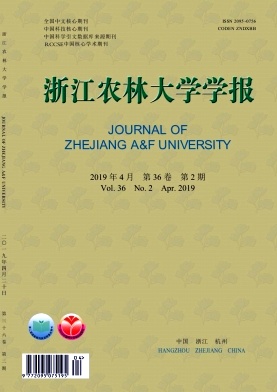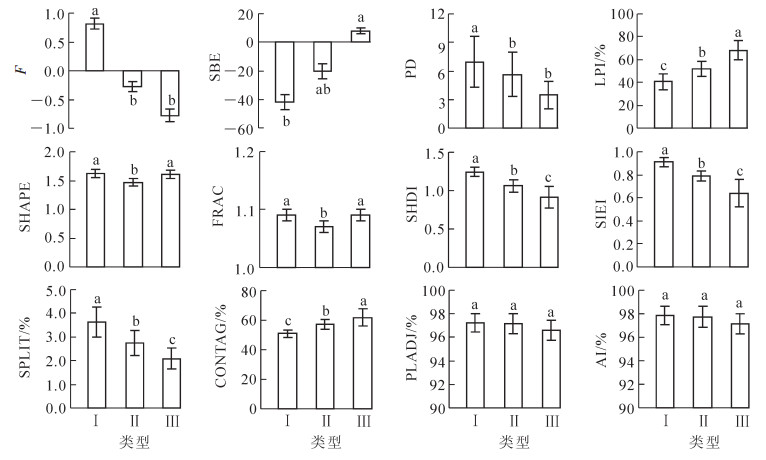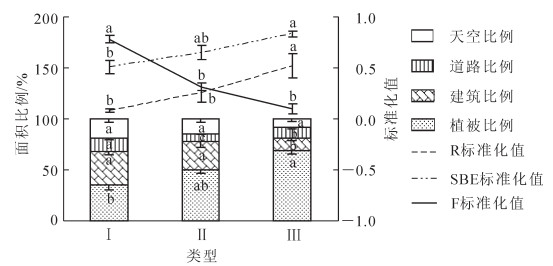-
建设城市森林是提高人居环境综合质量的重要途径。在高人口密度的城市围绕高层建筑构建城市森林,不仅能够在一定程度上满足城市环境需求,也是美化建筑背景景观的常见手法。在建筑物周边建设城市森林通常要符合建筑景观的空间和美学规则,如何验证这些规则(如植被的空间配置等)的科学性仍是悬而未决的问题。部分学者通过评价建筑外观的色彩、纹理及建筑与周围环境整合的合理性[1]进行小尺度研究,认为建筑外观、屋顶和植被显著影响了视觉景观质量,植被可缓和建筑生硬、毫无生机的缺点[2],有利于视觉感知的提高。为了从较大尺度上研究植被和建筑物的空间关系,有学者基于地理信息系统(GIS)等宏观手段,依据人们的偏好,从景观评价角度开展研究,探讨在城市周边环境景观中融入适宜建筑的方法[3]。目前研究普遍认为植被与景观美学质量呈正相关,而不合理的建筑会干扰周围环境整体秩序[4],降低视觉景观质量[5]。植被在景观中的空间位置通常会产生不同视觉构景和空间界定等,对建筑物的采光、建筑外观的遮挡、以及整体视觉景观的虚实感知、色彩和景物协调性均产生影响。同时,植被覆盖通过改变建筑的线条和形状,打破规则的几何特征,进而影响了乡村建筑景观整合的美学质量[6]。尽管中国学者从艺术角度在建筑周边植被的规划建设[7]与管理[8]以及植被配置合理性和生态服务功能评价等[9-10]领域开展了系列研究,依然鲜见植被与建筑耦合关系对视觉景观质量影响的报道。空间位置变化是植被规模、位置及其色彩等对城市森林视觉质量产生影响的根本原因,即空间异质性。在景观生态学中,异质性是反映地理事物空间分异规律的重要标志[11],直接影响资源、物种和干扰在景观中的分配与传播,对景观整体功能及生态过程有重要调控作用[12-13]。对于城市森林景观,视觉景观异质性可以理解为景观内各景物斑块或者色彩斑块的统计特性及其在空间上的关系。在城市森林景观研究中,有关景观结构[14]和美学质量评价[15-17]等报道较多,尤其是在中、大尺度上,采取景观生态学手法对某一城市或区域的城市森林景观开展景观格局的研究[18-20]较多,但鲜见开展小尺度的城镇森林视觉景观异质性的研究。鉴于此,本研究以高校具有建筑物背景的城镇森林作为研究对象,采用美学质量评价与景观生态学异质性相结合的方法,运用因子和聚类分析等方法,研究城镇森林景物空间异质性程度对公众喜好度的影响,进而从美学和整体景观特点揭示植被与建筑物空间的耦合关系,为提升具有建筑背景的城镇森林的景观质量提供理论支撑。
HTML
-
目前,城市森林景观已经基本稳定成型,为保证有较远的观赏距离,筛选了北京市海淀区高校校园内的典型景观进行调查,将以建筑为背景的城市森林景观作为研究对象,调查地点包括清华大学、北京航空航天大学、北京科技大学、北京语言大学、中国农业大学等9所高校。景观照片拍摄的原则是保证建筑物前或周边的植被画面完整,并保证观赏距离(拍照点到建筑物的距离)相对一致。以所拍摄照片中景物的范围为样地范围,对样地范围内的所有植被做详细调查。
-
照片拍摄选用尼康D300s相机,参数设置:光圈优先曝光、F11光圈、自动对焦模式;天气为典型晴天,采取横向拍摄,镜头高度为1.55 m。为了避免受观察点与楼宇之间距离的限制,并使植被在照片取景范围中最大化,统一在建筑物的侧前方拍摄景观照片。为避免景观照片的视觉质量强烈受光照的影响,统一在顺光光照下进行景观照片拍摄。共筛选了54张以建筑为背景的城镇森林景观照片。
采用美景度评判法[21](scenic beauty estimation,SBE)对照片的视觉美学进行评价,采用网络调查问卷形式(https://sojump.com/jq/10640099.aspx)进行评判,每张照片设置观察时间为5 s,回收222份评判结果,得到有效问卷207份。
每个景观的美景值(scenic beauty value)按照DANIEL等[21]方法计算:①按等级值大小顺序统计各等级值的频数(f);②计算各等级值的累计频数(fc);③计算累计概率(pc);④根据累计概率查正态分布单侧分位数值(z);⑤计算z的平均值(Z)。随机选取1张照片作为对照景观,其美景度值Si计算公式为:Si=(Zi-Zi)×100=0;其他景观的美景度值Sn为:Sn=(Zn-Zi)×100。其中:n∈[1, 54],Zi为对照景观的平均值,Zn为其他景观平均值。Sn绝对值越大,与对照景观的景观质量差距就越大。
-
根据城镇森林照片中视觉景观要素的主要构成成分,将景物类型划分为植被(乔、灌、草)、建筑、道路和天空等4类。利用Arc GIS 10.3软件手动勾画出照片中每个景观斑块的边界,将照片栅格化处理,然后采用FRAGSTATS 4.2软件提取照片中的景物斑块信息。手工勾绘照片中景物斑块的原则是:在充分放大像素的基础上,由目视直接判断照片中的景物,区分明显的景物斑块边界,并确定和勾绘边界;对于边界不十分明显的景物,通过色彩和形态加以辨认,确定所属类别后勾绘边界。为了分析照片中景物斑块的特性,本研究引入景观生态学中景观指标的概念,参考毛斌等[22]的方法选择了10个景观指标(表 1)。
景观指标 缩写及字母表示 含义 斑块密度 PD(x1) 景观照片单位面积上的景物斑块数量,其值越大,景观的破砕化程度越高 最大斑块指数 LPI(x2) 指某景物类型的最大斑块在整个景观中所占比例,描述优势景观斑块特征,该值越大,视觉景观越稳定 景观形态指数 SHAPE(x3) 指整个视觉景观中各类景物相应斑块指数值的总和除以斑块总数,该值越大,视觉景观形态特征和复杂程度越高 分形维数 FRAC(x4) 指景物斑块的面积与周长之比值,描述景观斑块的几何形状复杂程度,该值越高、斑块形状越不规则,边缘线越复杂 连通度指数 C0NTAG(x5) 描述视觉景观里不同拼块类型的团聚程度或延展趋势,该值越高,表明景观中的某种优势斑块类型形成了良好的连接性 景观多样性指数 SHDI(x6) 描述视觉景观中景物类型非均衡分布状况,景物斑块组成的多样性程度与视觉景观的多样性、异质性和破砕化程度相关,该值越大,说明斑块增加或各斑块类型在景观中呈均衡化趋势分布 景观均匀度指数 SIEI(x7) 描述景观中各景物斑块分配的均匀程度,该值越大,表示景物斑块分布越均匀 聚合度指数 AI(x8) 基于同类型景物斑块公共边界长度,反映视觉景观中不同景物斑块类型的非随机性或聚集程度,该值越大,景物斑块之间的公共边界的值越大 相似毗邻百分比 PLADJ(x9) 描述视觉景观类型内部的聚合程度,该值越小景观斑块越分散、景观的破砕化程度越高 分离度指数 SPLIT(x10) 指景物斑块的分离度与景物类型的面积指数之比,描述了视觉景观格局性质与特点,该值越大,表明景物斑块个体的分离程度越高 Table 1. Choose of landscape indicators
-
运用因子分析、聚类分析和简单相关性分析方法,采用R 3.4.2软件进行数据分析,Origin 8.0软件绘制直方图。
2.1. 照片拍摄、筛选与评判
2.2. 照片中景观斑块信息提取
2.3. 数据处理
-
森林景观的综合质量是由景观中斑块指标综合决定的,经常有部分指标有显著的间相关关系[23]。为此,通过主成分分析或因子分析实现降维,进而达到各因子轴间相互独立的目的[24]。
从统计角度出发,部分景观指标存在着显著的间相关关系[23],不满足相互独立的性质,直接纳入计算必会存有冗余。利用主成分分析法对10个景观指标提取主成分,以消除指数对某些影响因素的重复表达。从表 2可见:前3个主成分的累计贡献率达94.06%,其中:LPI,CONTAG,SPLIT,SHDI,SIEI在第1组分有较高载荷,这类指数反映了景观斑块结构特性,为组分F1,可描述景观的稳定性;PD,PLADJ,AI在第2组分有较高载荷,反映了斑块分散与聚集的特点,为组分F2,可描述景观的破碎化现象;SHAPE和FRAC在第3组分有较高载荷,反映了斑块形态等信息,为组分F3,可用于描述景观连通性。综合这3个组分,构建景观异质性(F)模型,描述景观稳定性的组分方差贡献率为50.63%,描述景观破碎化的组分方差贡献率为32.84%,描述景观连通性的组分方差贡献率为16.53%,可见结构是影响视觉景观异质性的主要方面。根据主成分得分矩阵确定3个主成分中每个变量所对应的系数,形成结构(F1),数量(F2)和形状(F3)3个视觉景观异质性组分方程:
项目 旋转后载荷矩阵 得分矩阵 主成分F1 主成分F2 主成分F3 主成分F1 主成分F2 主成分F3 特征值 4.762 3.089 1.555 累计贡献率/% 50.627 32.841 16.532 PD - 0.210 -0.942 -0.119 -0.016 -0.369 - 0.195 LPI - 0.947 - 0.179 0.110 -0.202 -0.023 0.033 SHAPE 0.019 0.003 0.980 0.011 0.131 0.564 FRAC -0.105 -0.332 0.886 -0.006 -0.005 0.464 CONTAG -0.972 0.124 -0.053 -0.218 0.072 - 0.021 PLADJ - 0.034 0.956 -0.243 -0.040 0.334 -0.013 SPLIT 0.914 0.027 -0.006 0.200 -0.020 0.006 SHDI 0.975 0.070 0.014 0.212 -0.003 0.024 SIEI 0.965 0.110 -0.076 0.208 0.000 -0.023 AI 0.000 0.957 - 0.241 -0.033 0.333 - 0.011 Table 2. Results of principal component analysis of landscape indexes
F1=-0.016x1-0.201x2+0.011x3-0.006x4-0.218x5+0.212x6+0.208x7-0.032x8-0.040x9+0.200x10;
F2=-0.368x1-0.023x2+0.131x3-0.005x4+0.072x5-0.002x6+0.001x7+0.333x8+0.334x9-0.020x10;
F3=-0.195x1+0.033x2+0.5639x3+0.464x4-0.020x5+0.024x6-0.022x7-0.010x8-0.012x9+0.006x10。
视觉景观异质性3个组分的特征根分别为λ1=4.762,λ2=3.089和λ3=1.555(表 2),以每个主成分所对应的特征值占所提取主成分总的特征值之和的比例作为权重[11],可得到景观异质性综合模型,即:
F=-0.161x1-0.104x2+0.142x3+0.072x4-0.090x5+0.110x6+0.102x7+0.091x8+0.087x9+0.096x10。
-
基于因子分析的3个异质性组分(F1,F2,F3)以及各样地的景观美学质量(SBE)进行聚类分析,采用R 3.4.2软件的层次聚类方法,选择3类为最终分类结果,按视觉景观异质性程度分为高异质、低质量视觉景观(类型Ⅰ);中等异质、视觉景观(类型Ⅱ);低异质、高质量视觉景观(类型Ⅲ)(图 1)。
-
3种类型景观的LPI,CONTAG,SPLIT,SHDI,SIEI,PD,SHAPE和FRAC景观要素均有显著或极显著差异,PLADJ和AI无显著差异(图 2)。①类型Ⅰ:高异质、低质量视觉景观。该类型景观视觉异质性为0.82,显著高于其他类型景观,美景度为-41.90,显著低于其他类型景观。从景观因子角度出发,LPI和CONTAG最低,分别为40.72和50.93,表明该类型景观的最大斑块小,连通性低;而PD,SPLIT,SHDI,SIEI,SHAPE和FRAC均最高,分别为6.96,3.62,1.24,0.91,1.62和1.09,可见该类型的景观破碎程度严重,混杂程度高,边界复杂、稳定性最差,形状和组成都很复杂,与另2种视觉景观类型相比,该类型的景观视觉感知差,美学质量低。②类型Ⅱ:中等异质质量视觉景观。该类型景观视觉异质性为-0.27,美景度为-20.45。F3组分因子SHAPE和FRAC在3种景观类型中最低,分别为1.47和1.07,可见,该种类型景观的斑块形状规则,边缘线简单。F1和F2组分中各因子值均居中等,相比景观类型Ⅲ来看,斑块连通性和稳定性差,破碎化程度高,景物斑块边界简单,但美学质量显著低于景观类型Ⅲ。可见,景观斑块边界连接过于简单,对视觉感知来说,会降低景观的美学质量。③类型Ⅲ:低异质、高质量视觉景观。该类型景观视觉异质性为-0.78,美景度为7.79,视觉异质性程度最低,同时景观的美学质量最高。该类型的SHAPE和FRAC几乎与类型Ⅰ相同,分别为1.61和1.09,斑块的边界复杂程度高,而LPI和CONTAG也最高,分别为68.16和61.85,表明该类型景观的最大斑块大,连通性强;而PD,SPLIT,SHDI和SIEI均最低,分别为3.47,2.09,0.91和0.64。可见该类型的景观破碎程度低,景观的结构比较稳定,且形态和边界富有一定的变化,景观不显单调,观赏效果好。
-
对不同样地的视觉构景组分占比(植被比例VE,建筑比例BU,道路比例PA,天空比例SK和植被建筑比R)进行分析。从表 3来看:不同的构景组分与视觉景观异质性、美学质量之间存在一定的相关性,其中视觉景观异质性与BU,PA呈显著的正相关(P=0.009,P=0.007),与VE和R呈负相关(P < 0.001,P=0.001);美景度与VE,R呈显著的正相关(P < 0.001,P=0.012),与BU呈显著负相关(P < 0.001);而随着视觉景观异质性的提高,景观的美学质量呈显著下降趋势(P=0.007)。以建筑为背景的城镇森林景观主要由植被和建筑组成。从图 3可见:视觉景观异质性、美景度、植被比例、建筑比例、道路比例和植被建筑之比均有显著差异,天空比例则无显著差异,具体表现为:类型Ⅰ中,视觉景观异质性最强且BU和PA最高,但美学质量最差,VE及R均最低,分别为35.06%和122.31%;类型Ⅲ中,视觉景观的异质性程度降低,硬质视觉景观BU和PA的占比也降低(分别降低了20.46%和2.28%),而VE和R显著提高(分别提高了33.57%和244.45%),景观的美学质量也显著提高。可见,当植被比例占景观视野68.63%且植被与建筑之比约为3.6倍左右时,以建筑为背景的城镇森林景观的视觉美学质量最佳。结合相关性来看(表 3),植被、建筑和道路都可能引起视觉景观异质性的显著变化,而天空不是引起景观美学质量差异的关键因素[25]。
构景要素 视觉景观异质性 美景度 皮尔逊相关性 P 皮尔逊相关性 P 视觉景观异质性F 1 - -0.504** 0.007 美景度SBE -0.504** 0.007 1 - 植被比例VE -0.798** 0.000 0.773** 0.000 建筑比例BU 0.491** 0.009 -0.714** 0.000 植被建筑比R -0.584** 0.001 0.478* 0.012 天空比例SK 0.357 0.067 -0.177 0.376 道路比例PA 0.508** 0.007 -0.224 0.262 说明:“-”表示无。*表示在0.05水平上存在显著差异,**表示在0.01水平上存在显著差异 Table 3. Correlation between factors and visual heterogeneity and SBE of landscape
3.1. 视觉景观异质性模型构建
3.2. 视觉景观异质性和美学质量综合分区
3.3. 视觉景观异质性与美景度关联分析
3.3.1. 不同视觉景观类型中景观指标对美景度的影响
3.3.2. 不同视觉景观类型中构景要素对美景度的影响
-
本研究探索了以建筑为背景的城镇森林景观美学质量特征,利用Arc GIS 10.3将研究对象分为植被、建筑、道路和天空等4种视觉景物类型,并用10个景观指标描述整体视觉景观及不同景物斑块之间的特点。对景观指标进行主成分分析降维,提取了结构、组成和形态3个主成分,解释率可达94.06%,经由3个组分的特征值推导出视觉景观异质性F,其中结构的方差贡献率达50.63%,组成组分的方差贡献率达32.84%,形态的方差贡献率达16.53%。视觉景观异质性与美景度之间存在极显著相关(P < 0.01),为探讨各样地视觉景观异质性与美景度之间的内在联系,对结构、组成和形态3组分与美景度进行聚类分析,将这54块样地分为3类。类型Ⅰ:高异质、低质量景观。视觉景观异质性最高,建筑比例高,植被比例低,视觉景观连通性差、结构不稳定且复杂多变,整体美学质量低。类型Ⅱ:中等异质质量景观。视觉景观异质性中等,建筑、植被比例、稳定性和连通性中等,但斑块边界和形状复杂度最低,景观美学质量仅次于类型Ⅰ景观。类型Ⅲ:低异质、高质量景观。视觉景观异质性最低,景观稳定性强,连通性高,斑块边界和形状富有一定的变化,美景度最高。
横向比较3种视觉景观类型,随着视觉景观异质程度加深,景观美学质量显著下降,主要体现在景观指标和构景要素的差异对城镇森林景观美学质量的影响。
从景观指标来看,PD,SPLIT,SHDI,SIEI与美学质量呈负相关。随着斑块数量、分离程度和多样性、均匀度的显著增加,视野中的景观复杂度提高,景观群体庞大、数量多、色彩浓重和枝叶杂乱、植物茂盛,给人以沉重、压抑或者不安的感觉[26],造成公众喜好度降低;LPI和CONTAG增加可提高美景度,可能是因为植被斑块占主导,视觉色彩上连续性强,整体呈现比较均匀的绿色色块,给人以视觉享受;SHAPE和FRAC变化有所不同,美景度最高和最低的景观边界和形状都很复杂。一般情况下,复杂的斑块边界会降低视觉感知,但本研究表明:高美学质量景观的斑块形状及复杂的边界反而能提高美景度,可能是因为该类型的景观视野中主要是植被,植被边界的变化来源于林冠线的起伏,而林冠线对林外景观美景度的影响大[27],相比建筑或道路等的复杂边界,人们比较喜欢林冠线变化明显的景观[28]。由此可知,破碎化程度低、斑块之间连通性高、整体结构稳定且植被边界具有一定变化的景观,公众的视觉感知效果好,喜好度评价高。
从构景要素来看,植被(VE),建筑(BU)和植被建筑比例(R)与美景度显著相关,其相关性由高到低分别为VE(0.773),BU(-0.714),R(0.478),即植被对以建筑为背景的城镇森林景观的美学质量影响力度最强,建筑影响次之。前人在探究滑雪场等4类景观要素时也发现,植物景观与美景度高度相关,服务性建筑相关性略低[29]。研究表明[30-31]:植被是提高美景度的重要因素,随着VE和R的增加,城镇森林的美学质量显著提高,而视觉景观中BU的增加反而降低了景观美学效果。本研究中,视觉景观均由建筑和植被构成,更高的植被覆盖比例,可以遮挡更多的建筑,在视觉上弱化建筑的生硬感[32],提高了视觉美学质量,类似研究也表明植被覆盖程度高的建筑景观,美学质量得分更高[33]。天空和道路对美景度无显著影响,这可能是因为天空和道路的形状和色彩单一,公众评价的关注点主要落在了植被和建筑上。
综上,以建筑为背景的城镇森林中,视觉景观异质性高,连通性差,结构不稳定,建筑边界复杂,植被林冠线过于单一的景观,美景度低。因而在城镇森林营建和景观质量提升过程中,不仅要遵循城市森林营建的基本原则(以乡土树种、地带性植被为主,建设结构稳定、配置合理的近自然森林景观等[34]),还需考虑视觉上的协调以及植被覆盖建筑面积的增加。本研究表明:当植被占视觉景观的比例约68.00%,植被与建筑之比约3.6时,城镇森林景观更易得到人们的视觉认可。近些年,墙体绿化(墙面、屋顶等[35-36])备受关注。墙体绿化除了依靠植被的高度,还可以利用藤本植物纵向生长特性,形成墙体绿色景观等,进而提高植被与建筑之间视觉比例,调节视觉体验,提高城镇宜居性。本研究尚未考虑城镇森林的树种组成、栽植目的、观赏角度以及色彩等因素对城市森林景观美学质量的影响,拟在后续试验中进一步探索和研究。










 DownLoad:
DownLoad:

